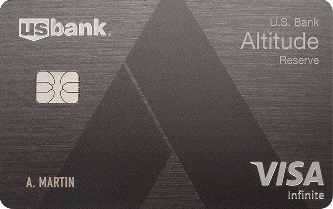
By: Jenny Reed - MilesTalk Group Moderator

US Bank has offered the Altitude Reserve for quite some time, and is now set to add two new cards to the Altitude family on March 30th. These new cards will be called the Altitude Go and the Altitude Connect. This is what we know about them, and an analysis of how good the Altitude family will be.
First, this is the structure of what each of the cards will earn, as initially reported by Doctor of Credit:
In this article
US Bank Altitude Go Earn Rate and Features:
- 4x Dining and Takeout
- 2x Groceries, Gas Stations, and Streaming Services
- 1x Everywhere Else
$15 “Free month of streaming services” (discussed below)
0% intro APR for 12 months on purchases and balance transfers
20,000 points after $1,000 spend in 3 months (initial welcome offer)
No annual fee
US Bank Altitude Connect Earn Rate and Features:
- 5x Prepaid Hotels and Car Rentals when booked with the Altitude Rewards Center
- 4x Travel and Gas Stations
- 2x Dining, Takeout, Groceries, and Streaming Services
- 1x Everywhere Else
$30 “Free month of streaming for annual streaming services” (discussed below)
50,000 points after $3,000 spend (initial welcome offer)
$95 annual fee (waived the first year)
US Bank Altitude Reserve Earn Rate and Features:
- 5x Prepaid Hotels and Car Rentals when booked with the Altitude Rewards Center
- 3x Mobile Wallet Purchases
- 3x Travel
- 1x Everywhere Else
$325 in annual travel credits, automatically applied
12 complimentary Gogo Inflight Wi-Fi passes each year
50,000 points after $4,500 spend (initial welcome offer)
$400 annual fee
Just to be clear, the Altitude Reserve already exists, and the Go and the Connect will premiere on March 30th.
A Suite of US Bank Altitude Cards
This is clearly intended to be a family of cards, where the idea is that these cards work together to form a solid group of cards that compliment each other inside your wallet. They hope that you will decide you want all three (and possibly any future additions to the family). This is meant to be like the Chase Ultimate Rewards family you are probably already familiar with, where the Chase Freedom, Chase Freedom Unlimited, and your choice of the Chase Sapphire Reserve or Chase Sapphire Preferred (plus the Chase Ink Business credit cards!) work together to make Chase’s Ultimate Rewards a solid earning proposition for someone who has the whole set.
If you have the entire suite of three Altitude cards, you will collectively (between the three of them) earn:
- 5x Prepaid Hotels and Car Rentals when booked with the Altitude Rewards Center
- 4x Travel, Gas Stations, Dining, and Takeout
- 3x Mobile Wallet Purchases
- 2x Groceries and Streaming Services
- 1x Everywhere Else
Plus, you will get 12 Gogo Inflight Wi-Fi passes, a $325 travel credit (which, sadly, must be spent on the card that doesn’t earn top travel rewards, but still a credit), and $45 worth of Streaming credits (in two discrete packages, on two different cards). Plus, you will net welcome bonuses of 120,000 points at the current offerings. Your total annual fee for the entire suite will be $495 after the first year (just $400 the first year).
After using the $325 credit, you wind up paying $170 all-in. If you use the full amount of streaming credits, you pay $125. If you also use all 12 Gogo passes, you come out ahead, getting “back” more with credits than you spend. (These cost variable amounts, but always at least $19.)
For complete accuracy, you may want to take note that for your $325 (and any overage) you spend on travel on the Reserve in order to get the credit, you are getting just 3x instead of 4x, which means you lose the value of 1 point per dollar, or a total of at least 325 points. At 1.5 cents per dollar, that’s $4.88 for exactly $325. But you still come out financially ahead on the whole package, assuming you use every bit of the credits. (But the secret to maximizing your rewards is to try to get as close to $325, exactly or just slightly over, as you can, in travel credits.)
Well, then, the question becomes: What are these US Bank Altitude points worth?
The simple answer is that we do not know for sure yet. We can make some good guesses, though.
Redeeming US Bank Altitude Points with the Altitude Reserve
The Altitude Reserve currently offers a redemption value of 1.5 cents per point when used for Real-Time Rewards. Real-Time Rewards are US Bank’s special thing, which distinguishes them from everybody else. Basically, Real-Time Rewards is like a travel eraser (like Capital One and Barclays do), with a twist. Two twists, actually. First twist: Points are worth 1.5 cents each (whereas they are worth just 1 cent with Capital One and Barclays). Second twist, which is totally unique and rather fun: US Bank will send you a text message asking you if you want to redeem your rewards, when you make a purchase that’s eligible for redemption and also meets minimum dollar amount criteria which you can adjust yourself. You just text REDEEM in reply if you want to redeem this particular purchase.
Most travel is eligible for redemption, including (but not limited to) purchases of flights on most airlines directly from the airline (a few airlines seem to fail to trigger the text, for whatever reason); purchase of airline gift certificates from Alaska, Delta, and American; airline awards fees and taxes; Lyft and Uber rides; purchase of Uber credit within the app; car rentals within the US; cruise purchases (both direct through the cruise line and indirectly through many online cruise agencies); cruise line onboard credit bill settling for most cruise lines; and for most hotels within the US. But you may notice that there is some randomness.
Some things that should qualify just don’t seem to trigger the Real-Time Rewards text. This is almost certainly an IT issue rather than intended, but it does happen. You should also be aware that typing REDEEM only redeems the most recent eligible charge, which can be an unsolvable problem if you have two charges in rapid succession that you had hoped to redeem for both – because only the second one to go through will be possible to redeem for. (This can happen if, for example, you buy two tickets together and the airline bills you twice rather than as a single purchase.) Still, when it works as intended, it’s really great to simply type REDEEM and get your travel erased just like that.
Redeeming US Bank Altitude Points on the New Line of Altitude Cards
So, then, the question becomes, what will the new cards and the future bring? What will be the value of the points on the new cards?
There are a small number of possible answers to that. Here’s a list of possibilities:
- The new cards will also be worth 1.5 cents per point for Real-Time Rewards.
- The new cards will be worth 1 cent per point for Real-Time Rewards, but if you also have the Reserve, then you can transfer your points from those cards to the Reserve for redeeming at 1.5 cents per point.
- Real-Time Rewards will be devalued to just 1 cent per point on all cards.
- US Bank will unveil a roster of partners you can transfer points to. (This is compatible with any of the above 3 options.)
At this point in time, not knowing what the future holds makes analyzing the value of Altitude points a little difficult.
That said, I personally believe that option 2 is the most likely: the new cards will have a “natural” value of 1 cent per point, but the value can be improved if you have the premium card. This copies the Chase suite’s plan, where having a Sapphire card makes your Freedom points more valuable. I honestly think that US Bank wants that synergy.
So, if that is the case, or if option 1 (where all cards are natively 1.5 cents per point) is the case, then Altitude points are effectively worth 1.5 cents each. Therefore, your value for spend, when you have the full suite and use the correct card for maximum value, looks like this:
- 7.5 cents per dollar (or 7.5% back) on Prepaid Hotels and Car Rentals when booked with the Altitude Rewards Center
- 6 cents per dollar (or 6% back) on Travel, Gas Stations, Dining, and Takeout
- 4.5 cents per dollar (or 4.5% back) on Mobile Wallet Purchases
- 3 cents per dollar (or 3% back) on Groceries and Streaming Services
- 1.5 cents per dollar (or 1.5% back) Everywhere Else
Other than the rich welcome bonuses, is that worth it?
Well, that’s obviously not bad, overall. But let’s compare those numbers more directly.
Comparing Altitude Points to Transferable Points from Citi ThankYou, Capital One Miles, Barclays Arrival Miles, American Express Membership Rewards, and Chase Ultimate Rewards – Non-Bonused Spend
We will be comparing these values two different ways, to fixed-value travel eraser points systems (Barclays and Capital One when used as a travel eraser) and to transferable points currencies (Amex, Citi, and Chase… and also Capital One).
Capital One offers 2 points per dollar on everything, with a value of 1 cent per point (when used as a travel eraser). That’s 2% back. (Or you can transfer points to airlines.)
The Barclays Arrival+ gives you even better returns, because it also offers 2 points per dollar on everything, with a value of 1 cent per point, but then it gives you 5% back after any travel redemption on top of that. Therefore, by comparison, the 1.5% back on everything else isn’t very good, because you can do better with Capital One or Barclays.
Meanwhile, you can get 2% cash back, which can be turned into 2 transferable ThankYou points per dollar, on all spend with the Citi DoubleCash. You can get 2 transferable Membership Rewards points per dollar with the Amex Blue Business Plus. Again, by comparison, the 1.5% back on everything else isn’t very good, because 2 transferable points is potentially worth much more than 1.5% back.
The thing with transferable rewards is that the value of the reward point ultimately depends on where to transfer it to. Depending on your choices, the value could be less than one cent or greater than 7 cents per point. This is why I say “potentially worth much more” because it all depends on how you choose to redeem. (And keep in mind that redeeming for maximum dollar value doesn’t always result in the vacation you actually want! True value is the happiness you get from your redemption.) But, that said, it’s safe to say that any card that offers transferable points can get you a satisfying reward that is valued at greater than 1.5% back, even on purchases that only earn 1 point per dollar (and you can do better than 1 point per dollar).
Therefore, once minimum spend for the bonus is accomplished, I strongly recommend that you look somewhere other than the Altitude suite for your non-bonused spend.
Comparing Altitude Points to Transferable Points from Citi ThankYou, Capital One, American Express Membership Rewards, and Chase Ultimate Rewards – Bonused Spend
But that bonused spend looks like a different story entirely.
Let’s say, for this discussion, that your average transferred point reward gets you 2 cents per point in value. Remember that this is an average, as it could go much higher or much lower, depending on how you transfer.
Let’s start with gas stations. (Also see: Best Credit Cards for Gas Stations).
You can get 3 transferable points per dollar from Citi Premier and Amex Everyday Preferred. If we redeemed at our average amount of 2 cents per point, that’s 6% back. (Again, though, it could go much higher… or lower.) This is an equal trade in value (in theory), where you could earn 6% back guaranteed in Real-Time Rewards. So, which one is better really depends on how you wish to redeem. If you wish to redeem for a cruise, for example, which cannot be redeemed with any transferable points currencies, then this is a great way to go. Likewise, if you wish to redeem for a reward on an airline or hotel with a low value reward, such as a very cheap flight or room night which is going for a lot of points, then this is also a better deal – and it has the bonus that the airline or hotel is not aware that you are redeeming card points, which means that you are earning airline or hotel points on your reward. Win!
What about Dining (and Takeout, which is really part of Dining, anyway)? (Also see: Best credit cards for Dining)
Well, you can get 4 transferable points on the Amex Gold or 5 transferable points on the Citi Prestige. Assuming you redeem at our average of 2 cents per point, you are getting an 8% and 10% return value, respectively. So, in this case, you are most likely better off using the Amex Gold or the Citi Prestige for your dining spend. However, if your goal is to redeem for a cruise, or if you know you’re aiming for a low-cost free flight or hotel room, then you might just feel like the 6% you get here is quite respectable, and works better with your end goals in mind. Still, I personally would use the Amex Gold as my primary restaurant card, and only use an Altitude when a restaurant does not take Amex. That said, there are enough restaurants that do not take Amex that this card would make sense as your backup if you do not find enough value in the Citi Prestige to carry it.
What about Travel? (Also see: Best Credit Cards for Airfare / Best Credit Cards for Hotels / Best Credit Cards for Car Rentals)
You get 6% back on most travel, and 7.5% back on Prepaid Hotels and Car Rentals (using their own travel portal). By contrast, you can get 3 points per dollar on all general travel (Citi Premier, Chase Sapphire Reserve, and Chase Ink Preferred), and up to 5 points per dollar on special sub-categories of travel (flights, hotels, etc) from several cards. At our average of 2 cents per point, that’s 6% on general travel and up to 10% on special sub-categories. So, what we’re saying is, for general travel, it’s the same equation as gas stations: it’s theoretically equal, but in practice, depends on how you intend to redeem. Likewise, for Prepaid Hotels, you can get a theoretically equal deal from Amex – though that is also complicated by what hotels might be available within the respective travel portals and whether the prices are the same. But for prepaid car rentals, well, I believe (correct me if I’m mistaken) that nobody else has a special raised category for this. As far as points are concerned, this might be the best deal around for prepaid car rentals. Of course, I should mention that we have absolutely no idea what sort of insurance the Altitude Connect will offer, but the Altitude Reserve offers primary insurance which is quite good. That also matters quite a bit when making your decisions.
The Altitude Bonus Category for Using a Mobile Payment
What about the Mobile Wallet thing? Well, frankly, nobody else anywhere offers a Mobile Wallet bonus of any size. So 4.5% back is quite literally not only the best offer out there, but it’s the only offer out there. But exactly what is a Mobile Wallet bonus? Basically, many stores give you the option to pay with a mobile wallet, such as Samsung Pay or Apple Pay. To do this, you use an account with one of these services sort of in place of using a credit card at the cash register. Now, you actually have a credit card attached – specifically, your Altitude Reserve card, obviously. So you are paying with your Altitude Reserve, but indirectly. You give the store your mobile wallet, and they charge the mobile wallet, which charges the card. It’s roundabout, but it works nicely. If mobile wallets are set up, either in a physical store or online, you just use the wallet and go. And what it means in terms of rewards is that you get 4.5% back at a lot of places that would otherwise be non-bonused spend. Compared to 2 points per dollar at our average of 2 cents per point, which equals 4% back, this category looks pretty good. (Again, it does ultimately depend on your final redemption… but this one is pretty solidly in favor of the Altitude family overall.)
But then, we get to Groceries. (Also See: Best Credit Cards for Groceries)
You can get 4 points per dollar from Amex Gold or 4.5 points per dollar from Amex Everyday Preferred, which equals 8% and 9% returns at our average rate of 2 cents per point. The Altitude family’s 3% back doesn’t even rate in this comparison. Amex remains the grocery grail.
And finally, there’s Streaming. (Also See: Best Credit Cards for Streaming Services)
This is an interesting category. Streaming services are becoming more popular by the day, with more and more people signing up for multiple services, and there aren’t a lot of personal cards that bonus them. However, it is covered under Chase’s Internet and Phone category for the Chase Ink Cash, which means it gets 5 points per dollar there. At our average rate of 2 cents per point, that’s 10%. The Chase Ink Cash blows away the Altitude family’s measly 3%, here. But, of course, there is the caveat. With each of the two new Altitude cards, you get a Streaming credit, which is worded as “Free Month of Streaming Services” for each card. The Go gives you $15 and the Connect gives you $30. Now, we don’t know for sure exactly what the weird wording of “Free Month of Streaming Services” means, exactly. Doctor of Credit is theorizing that it means that you can get one “free month” aka one streaming card charge of up to that amount reimbursed. Assuming he is right, that means that a charge of $4.99 would waste $10.01 of the credit (because it can only be applied to one charge), while a $20 charge would get the first $15 wiped off it (but you’d still pay $5). But we don’t know that for sure. All we know for sure is that there is a credit. In any case, it certainly makes sense to use the credit, even if, once you’ve done so, you transfer the regular charges back to the Chase Ink Cash (which I recommend).
So, basically, the best deals on the Altitude suite are the Prepaid Cars and the Mobile Wallet. The Prepaid Hotels, general Travel, and Gas Station options could also be good choices to spend on, depending on how the variables fall in each case. And the Dining is okay as a backup to the Amex Gold, unless you have the Citi Prestige.
What if the Point Value Drops to a Penny Per Point?
Now, what about the case where US Bank suddenly decides to cut the Altitude family (even the existing Reserve) to 1 penny per point on the redemption side? Although that ought to seem unlikely, we do know that US Bank acted in bad faith by doing just that to the FlexPerks cards. (Although the FlexPerks cards do still transfer points to the Altitude Reserve, at least for now.) While they also discontinued the FlexPerks cards in conjunction with this move, they have shown they are capable of doing it all the same. So, with that in mind, what happens if US Bank decides that Altitude points are worth just 1 cent per point across the board? Well, pretty much all of that stuff above goes out the window. You get better deals across the board from other cards. You could still find some value in booking cruises or really cheap hotel room or airfare rates, but the value is nowhere near as good.
What if US Bank Introduces Transferable Points?
But, on the OTHER hand… what if US Bank is about to premiere a transferable currency system? Well, it would be ideal if that transferable currency system also worked with 1.5 cents per point values on Real-Time Rewards, so you can have the ultimate choice. I mean, that would be the best of all worlds. But even if US Bank cuts Real-Time Rewards to just 1 cent per point, transferable rewards are a whole different ballgame that might make the value of Real-Time Rewards mostly irrelevant.
Of course, the big unknown with transferable rewards from US Bank would be what the transfer ratio is. Most banks transfer most currencies at 1:1. (Capital One is the exception, transferring at 3:2 aka 1.5:1.) US Bank seems to be trying to copy the Chase model, so that is an argument in favor of a 1:1 transfer currency. (And while the argument against it is that the new cards include 4x and 5x categories, other banks also have 4x and 5x categories and still transfer 1:1.)
So, in the case of 1:1 transfers, this suite of cards looks like a world-class option. Assuming you like the transfer partners, then these cards would become top choices for:
- 5x Prepaid Cars when booked in the Altitude Rewards Center
- 4x Travel and Gas Stations
- 3x Mobile Wallet
This suite of cards also becomes a very strong contender in the space for Prepaid Hotels (equal with Amex Platinum‘s 5x on Prepaid Hotels) and 4x on Dining and Takeout (equal with Amex Gold‘s 4x on Dining (Takeout included as Dining); less than Prestige’s 5x on Dining, though).
Likewise, 1.5x is considered respectable for non-bonused spend, on par with Chase Freedom Unlimited and Amex Everyday Preferred at 1.5x each, as well as Capital One when used as a transferable currency (at 2 Venture points equals 1.5 airline miles), but less than Citi Double Cash or Amex Blue Business Plus at 2x each.
You would still definitely want to go elsewhere for Streaming after you’ve used the credit (Chase Ink Cash has 5x), and for Groceries at all times (Amex Gold at 4x or Amex Everyday Preferred at 4.5x).
Basically, with transferable rewards at 1:1 ratios, these cards become some of the hottest cards in town.
But what if the ratio isn’t 1:1? Well… again, that changes everything for the worse. But I think that’s rather unlikely!
Summary
The new suite of Altitude cards is US Bank’s entry into the card family concept. These cards are meant to compliment each other and bring you a fairly well-rounded suite of rewards categories if you have all three.
These cards have a pretty strong set of perks, which could actually be worth more than the fees for the full suite of cards if you were able to fully use these perks.
Given the Altitude Real-Time Rewards redemptions at 1.5 cents per point as they exist now, these cards also offer a few categories that are worth putting spend on in the long term. But if the rumors of US Bank premiering a transferable currency come out, and it transfers to a few good partners at a 1:1 ratio, then the Altitude suite of cards will suddenly become the hottest cards to have in anybody’s wallet.
On the other hand, if the alternate rumors about Real-Time Rewards redemptions dropping to just 1 cent per point come true, and this is not also accompanied with a transferable currency to make up for the loss in value, then these cards become quite weak and will not offer very much value for regular spend. (Though the perks still might make these cards worth getting and keeping, for the subset of people who will use these perks well.)
Best Cards for Each Bonus Category
If you aren’t familiar with Your Best Credit Cards, it allows you to see the highest earning cards for each bonus category:
- Best Credit Cards for Dining
- Best Credit Cards for Supermarkets
- Best Credit Cards for Airfare
- Best Credit Cards for Hotels
- Best Credit Cards for Gas Stations
- Best Credit Cards for Office Supplies
- Best Credit Cards for Car Rentals
- Best Credit Cards for Shipping
- Best Credit Cards for Cable, Internet, and Phone
- Best Credit Cards for Social Media/Search Engine Ads
- More Best Bonus Categories
What are your thoughts on the US Bank Altitude card lineup?
Let me know here, on Twitter, or in the private MilesTalk Facebook group.
You can find credit cards that best match your spending habits and bonus categories at Your Best Credit Cards.
New to all of this? The MilesTalk “introduction to miles and points” book, MilesTalk: Live Your Wildest Travel Dreams Using Miles and Points is available on Amazon and at major booksellers.














